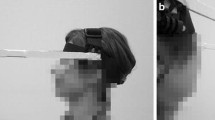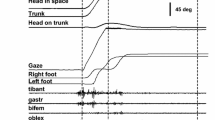Abstract
As individuals stand or walk in an environment their gaze may be reoriented from one location to another in response to auditory or visual stimuli. In order to reorient gaze, the eyes and/or the head and trunk must rotate. However, what determines the exact degree of rotation of each segment while standing or walking is not fully understood. In the current study we show that when participants were asked to reorient their gaze towards light cues positioned at eccentric locations of up to 90° while standing or walking on a treadmill their eyes and head mainly facilitated the action. Rotations of the head-in-space were similar for both tasks, but the rotation of the shoulders- and hips-in-space were lower for the treadmill walking condition. It is argued that this difference in the level of head-on-trunk rotation during the two tasks is controlled by the vestibular feedback loop. The regulation of this feedback loop is performed by the cerebellum in response to the level of threat to postural stability.





Similar content being viewed by others
References
Biguer B, Jeannerod M, Prablan C (1982) The coordination of eye, head, and arm movements during reaching at a single visual target. Exp Brain Res 46(2):301–304
Cathers I, Day BL, Fitzpatrick RC (2005) Otolith and canal reflexes in human standing. J Physiol 563(1):229–234
Crundall D, Underwood G, Chapman P (1999) Driving experience and the functional field of view. Perception 20:1075–1087
Findley JM, Gilchrist ID (2004) Active vision: the psychology of looking and seeing. Oxford University Press, Oxford
Freedman EG, Sparks DL (2000) Coordination of the eyes and head: movement kinematics. Exp Brain Res 131:22–32
Grasso R, Glasauer S, Takei Y, Berthoz A (1996). The predictive brain: anticipatory control of head direction for the steering of locomotion. Neuroreport 26:1170–1174
Grasso R, Prevost P, Ivanenko YP, Berthoz A (1998). Eye-head coordination for the steering of locomotion in humans: an anticipatory synergy. NeurosciLett 253:115–118
Hollands MA, Patla AE, Vickers JN (2002) “Look where you’re going!”: gaze behaviour associated with maintaining and changing the direction of locomotion. Exp Brain Res 143:221–230
Hollands MA, Ziavra NV, Bronstein AM (2004) A new paradigm to investigate the roles of head and eye movements in the coordination of whole body movements. Exp Brain Res 154:261–266
Land MF (2004) The coordination of rotations of the eye, head and trunk in saccadic turns produced in natural situations. Exp Brain Res 159:151–160
Manzoni D, Pompeiano O, Andre P (1998) Neck influences on the spatial properties of vestibulospinal reflexes in decerebrate cats: role of the cerebellar anterior vermis. J Vestib Res 8:283–297
Massion J, Woollacott MH (2004) Posture and equilibrium. In: Bronstein A, Brant T, Woollacott MH, Nutt JG (eds) Clinical disorders of balance, posture, and gait. Arnold, London, pp 1–19
Melvil-Jones G (2000) Posture. In: Kandel ER, Schwartz JH, Jessell TM (eds) Principles of neural science. McGraw-Hill, New York, pp 816–831
Ouchi Y, Okada H, Yoshikawa E et al (1999) Brain activation during maintenance of standing postures in humans. Brain 122:329–338
Outerbridge JS, Melvil-Jones G (1971) Reflex vestibular control of head movement in man. Aerospace Med 42:935–940
Patla AE, Vickers JN (2003) How far ahead do we look when required to step on specific locations in the travel path during locomotion? Exp Brain Res 148(1):133–138
Plainis S, Chauhan K, Murray IJ, Charman WN (1999) The effect of performing a cognitive task on detection thresholds; eccentricity and task-difficulty effects. Vision in vehicles VIII, Boston
Sanders AF (1963) The selective process in the functional visual field. Report IZF22. Institute for Perception RVO-TNO, Soesterberg
Sanders AF (1970) Some aspects of selective process in the functional field of view. Ergonomics 13(1):101–117
Vallis LA, Patla AE, Adkin AL (2001) Control of steering in the presence of unexpected head yaw movements. Influence on sequencing of subtasks. Exp Brain Res 138(1):128–134
Wilson VJ, Melvil-Jones G (1979) Mammalian vestibular physiology. Plenum, New York
Author information
Authors and Affiliations
Corresponding author
Rights and permissions
About this article
Cite this article
Cinelli, M., Patla, A. & Stuart, B. Involvement of the head and trunk during gaze reorientation during standing and treadmill walking. Exp Brain Res 181, 183–191 (2007). https://doi.org/10.1007/s00221-007-0914-3
Received:
Accepted:
Published:
Issue Date:
DOI: https://doi.org/10.1007/s00221-007-0914-3




